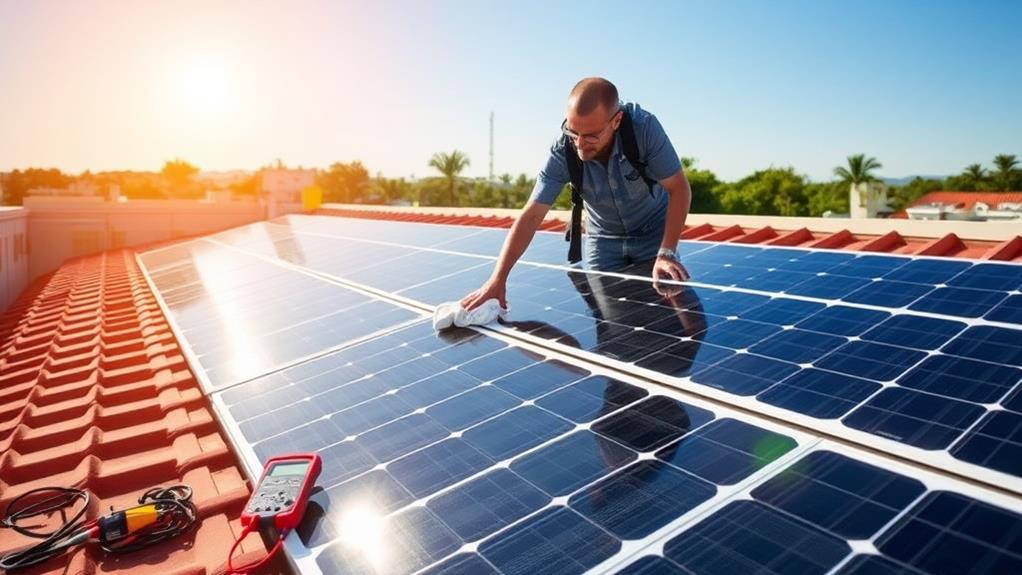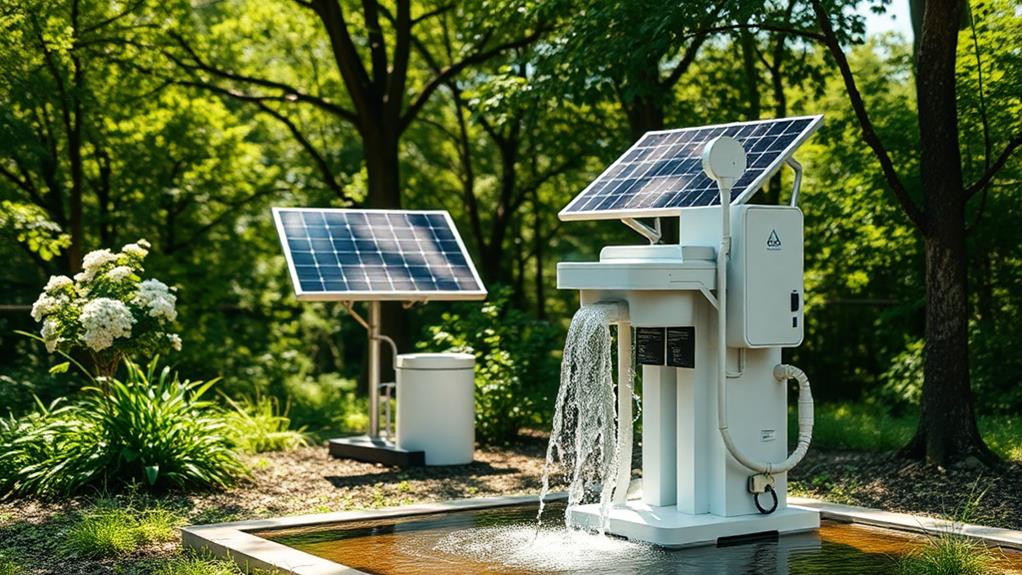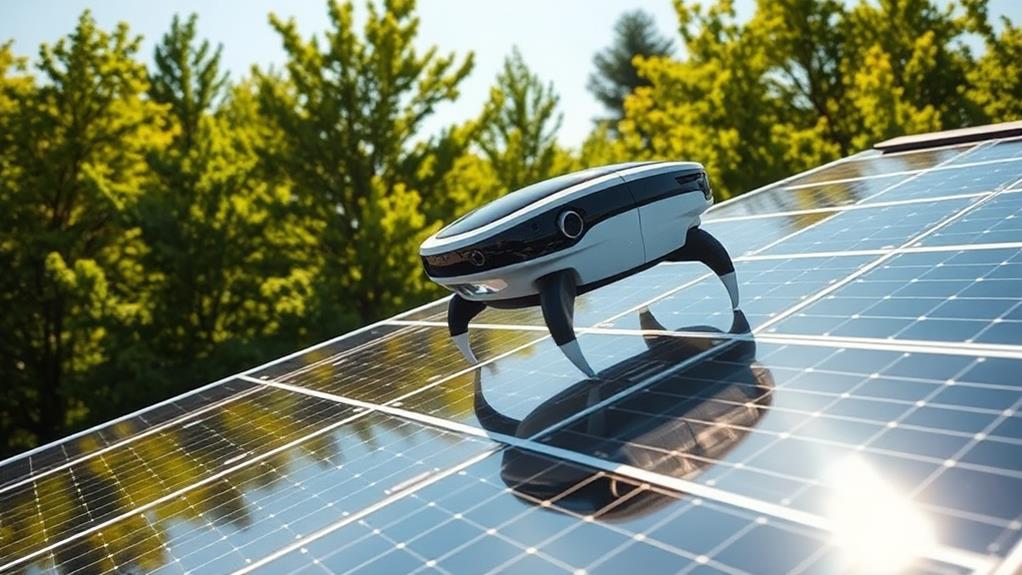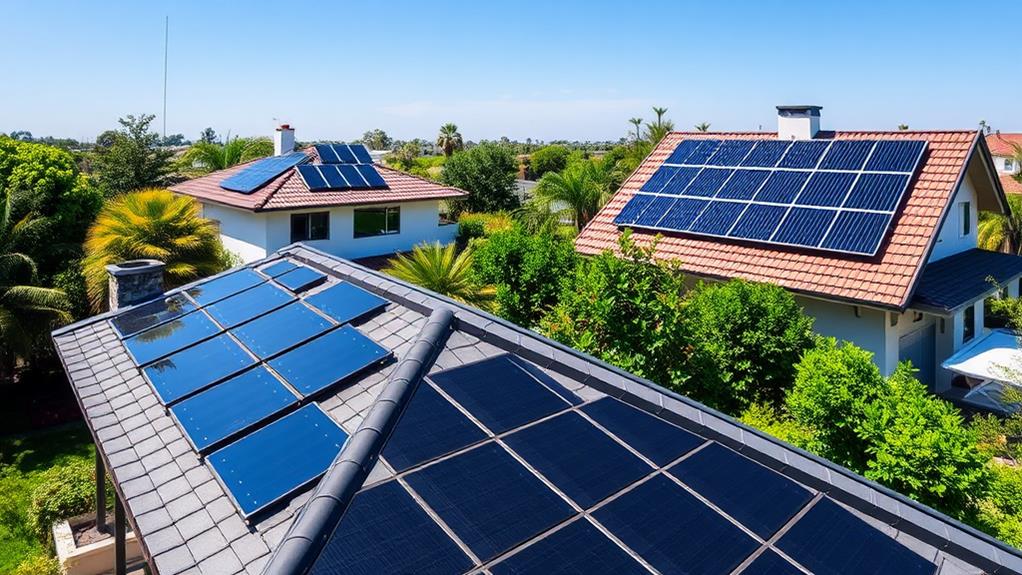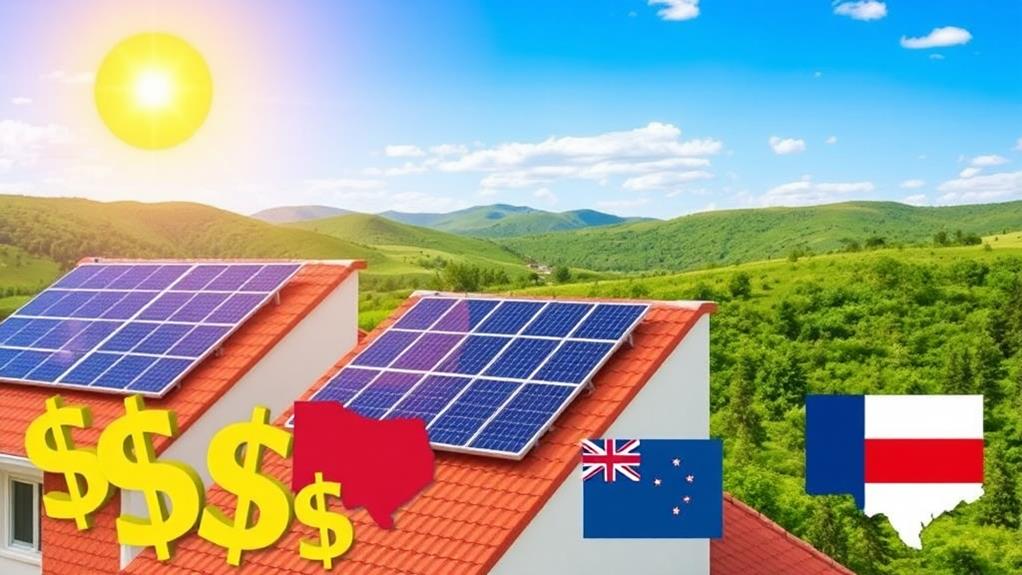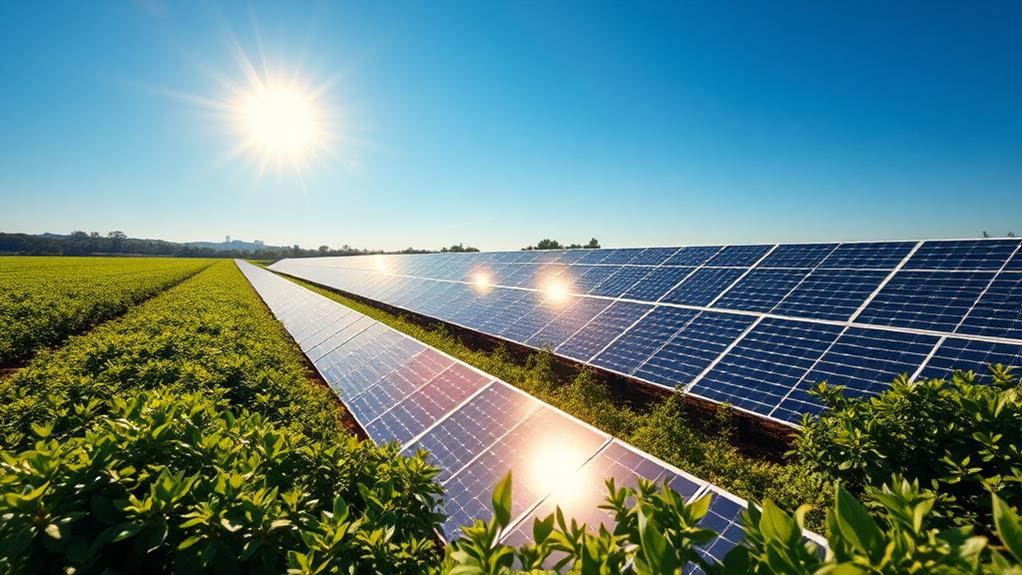Concentrated Solar Power (CSP) plants comprise several key elements, including advanced solar concentrating technologies, robust thermal energy storage systems, and efficient power generation components. We typically see two main types of CSP systems: power tower systems, which use heliostats to focus sunlight onto a central receiver, achieving high temperatures, and linear concentrator systems, such as parabolic troughs that operate between 150°C and 350°C. Thermal energy storage, often via molten salt, enhances reliability by allowing electricity generation even during non-sunny periods. With a global capacity of 8.1 GW as of 2023, CSP represents a significant stride towards sustainable energy solutions. Exploring further will uncover additional insights.
Key Takeaways
- Concentrated Solar Power (CSP) uses mirrors or lenses to focus sunlight, generating heat for steam turbines and electricity production.
- Key systems include Power Tower and Linear Concentrator systems, optimizing sunlight concentration and thermal energy conversion.
- Thermal energy storage, often using molten salt, enhances reliability by enabling energy generation during non-sunny periods.
- CSP plants have significant environmental benefits, generating electricity without carbon emissions and supporting renewable energy goals.
- High initial capital costs are offset by tax incentives and ongoing innovations in efficiency and material reduction.
Overview of CSP Technology
When we look at the world of renewable energy, Concentrated Solar Power (CSP) technology stands out for its innovative approach to harnessing sunlight. CSP technology utilizes mirrors or lenses to focus sunlight onto a small area, generating heat that drives steam turbines for electricity production. This method can achieve solar-to-electricity efficiencies ranging from 7% to 25%, highly dependent on the specific technology employed and environmental conditions. Remarkably, thermal energy storage systems enhance the reliability of CSP plants, allowing energy generation even during non-sunny periods. As of 2023, the global installed capacity of CSP reached 8.1 GW, with significant contributions from large-scale projects like the Ivanpah Solar Electric Generating System and the Ouarzazate Solar Power Station, showcasing the potential of concentrated solar power in our energy future.
Types of CSP Systems
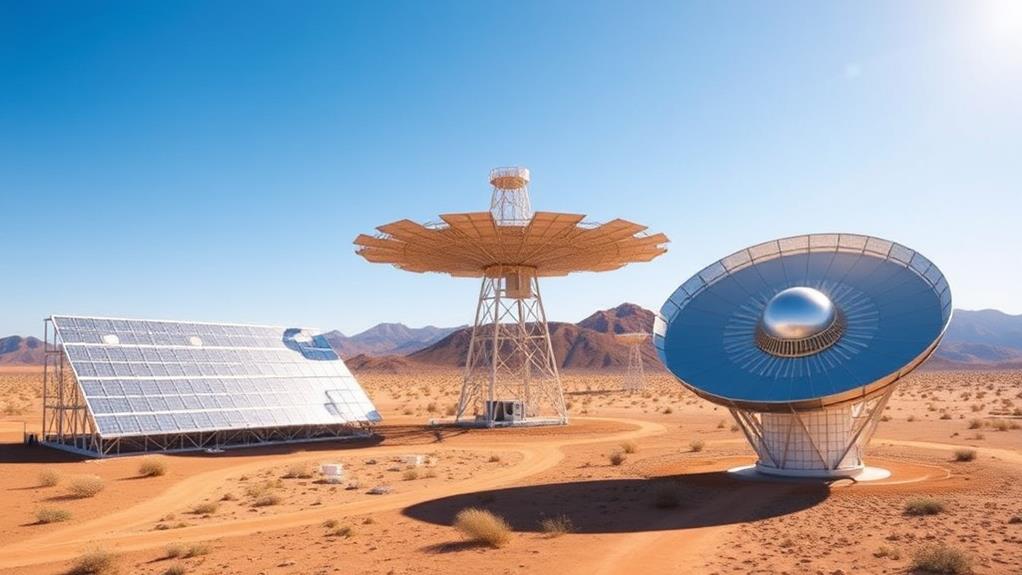
As we explore the types of Concentrated Solar Power (CSP) systems, it is crucial to recognize the distinct characteristics of Power Tower Systems and Linear Concentrator Systems. Power Tower Systems utilize a field of heliostats to concentrate sunlight onto a central receiver, achieving high operational temperatures around 600°C, which enhances steam generation efficiency. In contrast, Linear Concentrator Systems, including technologies like Parabolic Troughs and Linear Fresnel, employ long mirrors or rows of flat mirrors to focus sunlight, allowing for effective thermal energy capture and integration with thermal storage solutions.
Power Tower Systems
Power Tower Systems stand out in the domain of Concentrated Solar Power (CSP) technologies due to their unique design and operational efficiency. These systems utilize a field of heliostats that track the sun, reflecting sunlight onto a central tower-mounted receiver, achieving steam generation temperatures around 600°C. The concentrated sunlight heats molten salt as a heat transfer fluid, enabling thermal energy storage for later use, greatly enhancing efficiency and dispatchability. Power Tower Systems excel in high direct sunlight areas, making them ideal for utility-scale solar energy projects. Remarkably, the Ivanpah Solar Electric Generating System exemplifies this technology with a capacity of 392 MW, utilizing over 173,000 heliostats.
| Feature | Details |
|---|---|
| Efficiency | High thermal efficiencies, often exceeding 90% |
| Energy Storage | Molten salt for thermal energy storage |
| Capacity | Suitable for projects exceeding 90 MW |
Linear Concentrator Systems
Linear concentrator systems play an essential role in the concentrated solar power landscape, offering two primary types: parabolic troughs and linear Fresnel reflectors. These systems utilize long, curved mirrors to focus sunlight onto a receiver tube, generating heat that produces steam for electricity generation.
- Parabolic troughs operate efficiently at temperatures between 150°C and 350°C using thermal oils as heat transfer fluids.
- Linear Fresnel reflectors feature a compact design with flat mirrors arranged in rows, achieving medium concentration factors.
- Both systems can incorporate thermal energy storage solutions, such as molten salt, enhancing energy output during non-sunny periods.
Thermal Energy Storage
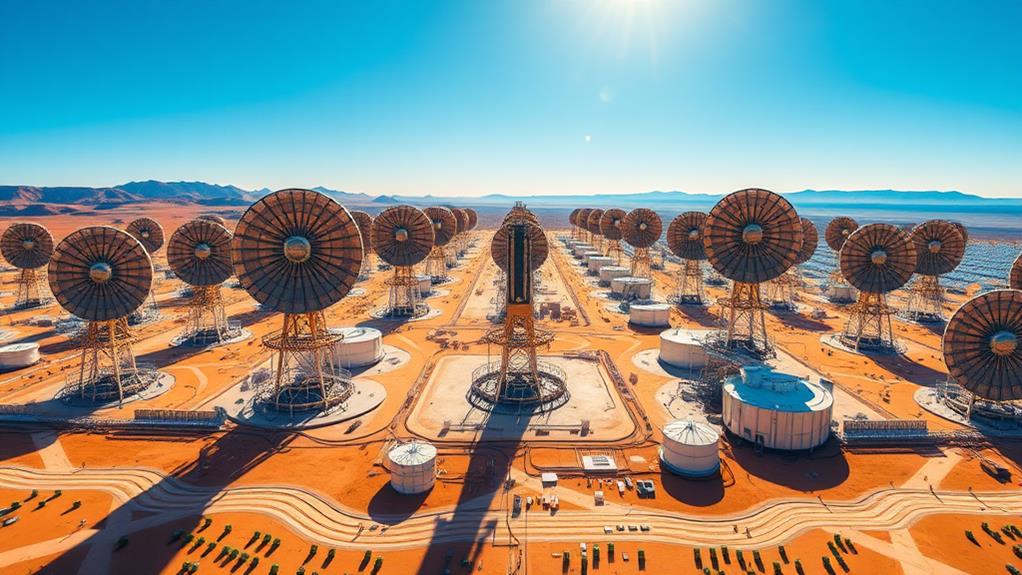
Thermal energy storage systems play an essential role in the efficiency and reliability of concentrated solar power (CSP) plants. They enable us to capture and store heat generated during peak sunlight hours, allowing for electricity generation even when the sun isn't shining. A common medium, molten salt, can retain heat at temperatures exceeding 500°C, providing energy for hours or even days post-sunset. This incorporation considerably enhances the dispatchability of CSP plants, enabling on-demand energy delivery and improving grid stability during peak consumption periods. With advancements in thermal storage technology, such as the use of ceramic particles, we can increase heat storage capacity and efficiency, ultimately achieving round-the-clock electricity generation, with some facilities offering power for up to 15 hours after sunset.
Key Components of CSP Plants
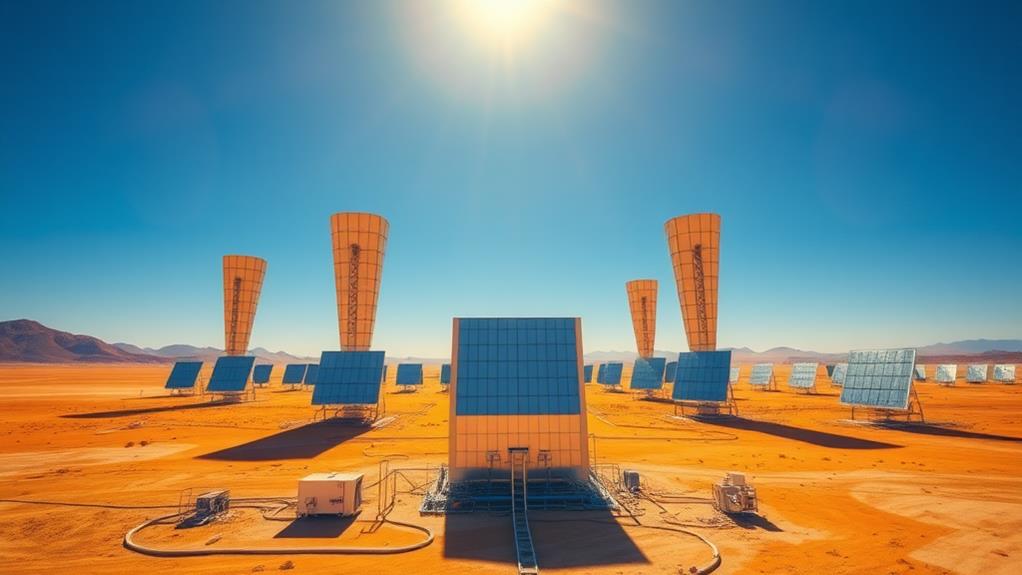
As we explore the key components of Concentrated Solar Power (CSP) plants, we'll focus on the essential technologies that enable efficient solar energy conversion and storage. These components include advanced solar concentrating technologies, robust thermal energy storage systems, and effective power generation systems, each playing a critical role in maximizing energy output and operational efficiency. Understanding how these elements interact will provide us with valuable insights into the overall functionality and potential of CSP plants.
Solar Concentrating Technology
In concentrated solar power (CSP) plants, several key components work together to harness sunlight efficiently. The technology behind CSP involves intricate designs and materials that optimize energy capture and conversion. The main components include:
- Solar collectors like parabolic troughs and power towers that focus sunlight using mirrors.
- Heliostats that track the sun's movement, directing concentrated sunlight to the receiver at the tower's apex.
- Steam production systems that use thermal energy for electricity generation.
These components enable effective solar-to-electricity conversion, achieving efficiencies ranging from 7% to 25%. As we explore renewable energy technologies, CSP stands out for its ability to produce high temperatures, making it a promising solution for sustainable energy and reducing reliance on fossil fuels.
Thermal Energy Storage
One of the most essential aspects of concentrated solar power (CSP) plants is their ability to store thermal energy, ensuring a steady power supply even when sunlight isn't available. Thermal energy storage typically utilizes molten salts, which can retain heat at high temperatures of around 400°C, allowing these CSP systems to generate electricity during peak hours or after sunset. This capability enhances grid reliability and provides energy on demand, with some plants storing enough thermal energy to supply electricity for up to 15 hours. Innovations, including advanced ceramics, aim to improve heat retention efficiency and reduce costs associated with molten salts. Overall, integrated thermal storage solutions greatly enhance system efficiency, enabling CSP plants to meet fluctuating energy demands more consistently.
Power Generation Systems
A concentrated solar power (CSP) plant relies on several key components that work together to harness solar energy effectively. The solar field, equipped with mirrors or heliostats, tracks the sun, directing concentrated sunlight onto the receiver. This receiver absorbs the sunlight, converting it into thermal energy by heating a fluid, typically thermal oil or molten salt.
Key components of the power generation system include:
- Mirrors and heliostats that focus sunlight.
- Receiver that converts sunlight into thermal energy.
- Electricity generator that transforms steam into electricity.
The thermal energy produced generates steam that drives the turbine connected to the electricity generator, allowing for efficient power generation. Furthermore, thermal energy storage systems enhance reliability, enabling energy production even during non-sunny periods.
Environmental Impact of CSP

Concentrated Solar Power (CSP) plants offer a promising alternative to fossil fuels by generating electricity without releasing carbon dioxide or other harmful pollutants. This greatly reduces greenhouse gas emissions, contributing to a cleaner environment. However, we must consider the environmental assessments associated with CSP projects, as large land areas are often required, particularly in desert ecosystems. These installations can disrupt local wildlife habitats and affect biodiversity. Additionally, while high solar flux from CSP mirrors can lead to avian mortality, in some cases, facilities are adopting advanced cooling systems that mitigate substantial water consumption. By prioritizing sustainable development practices and carefully considering ecological impacts, we can work towards a balance between renewable energy production and environmental preservation.
Economic Considerations
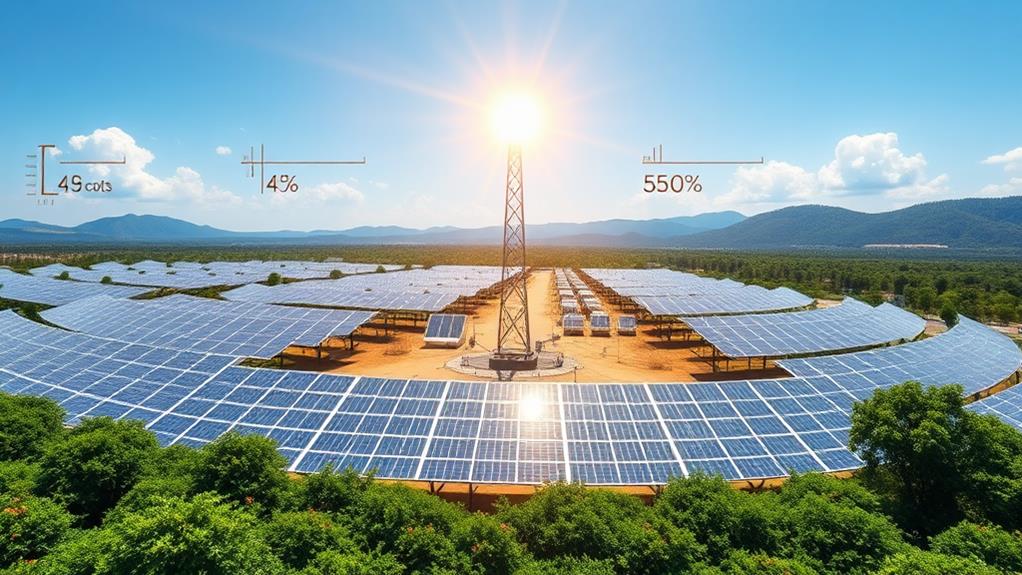
Economic considerations play an essential role in the development and viability of concentrated solar power (CSP) plants. While the initial capital costs for CSP plants can be considerably high, requiring substantial investment for installation and infrastructure, the benefits can outweigh these challenges.
- Thermal energy storage allows us to generate electricity during non-sunny hours, optimizing grid integration.
- The 30% investment tax credit in the U.S. supports project development, especially in areas rich in solar resources.
- Ongoing research and development efforts aim to enhance efficiency and reduce material costs, making CSP more cost-competitive with traditional energy generation.
As we advance, CSP shows promise in becoming a viable alternative in the renewable energy landscape, driven by technological innovations and economic incentives.
Applications of CSP
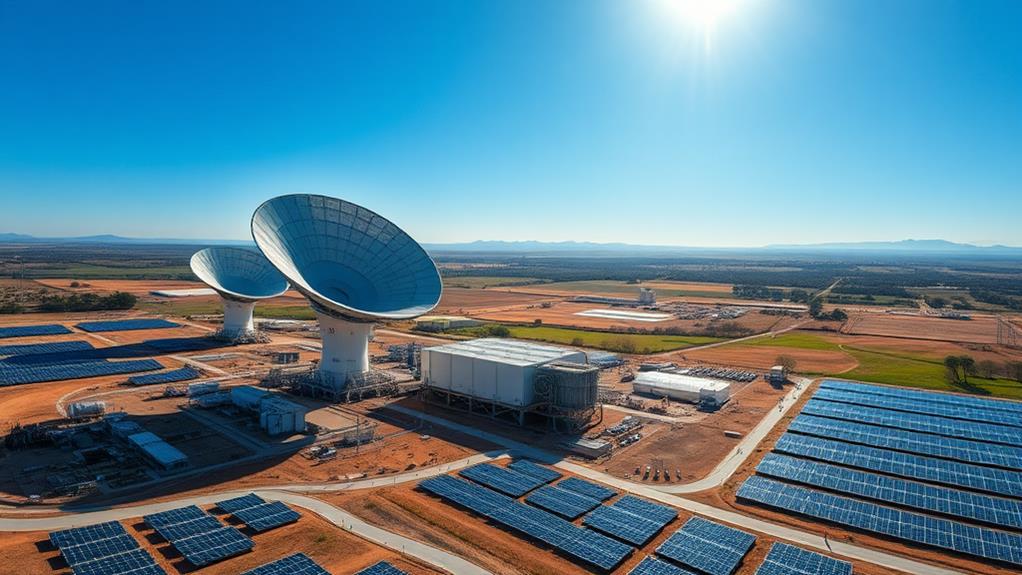
CSP plants serve multiple essential applications beyond just large-scale electricity generation. Utilizing CSP technology, these systems convert sunlight into thermal energy, which not only drives steam turbines for electricity generation but also supports various industrial processes. For instance, they offer important heat for enhanced oil recovery, chemical production, and mineral processing, thereby reducing our reliance on fossil fuels. Additionally, CSP plants play a key role in water desalination, where the thermal energy is harnessed to produce freshwater from seawater, addressing water scarcity in arid regions. With thermal energy storage capabilities, concentrated solar power plants can generate electricity even during non-sunny periods, enhancing grid reliability. The Noor Power Station in Morocco exemplifies this potential, boasting a capacity of 510 MW and contributing considerably to renewable energy goals.
Future Trends in CSP
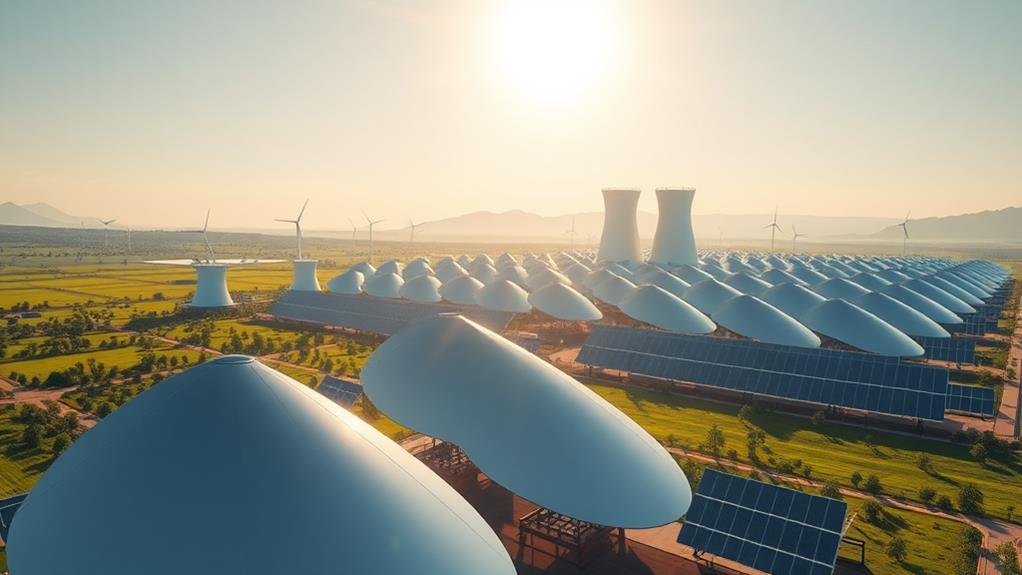
As we look ahead, the future of concentrated solar power (CSP) is set to be shaped by several exciting trends that promise to enhance its viability and efficiency. These advancements will not only support our global commitment to renewable energy but also help meet ambitious clean energy targets.
- The integration of advanced thermal storage technologies will improve system reliability, enabling energy generation during non-sunny periods.
- Ongoing research aims to reduce CSP costs, making it competitive with photovoltaic systems.
- The rise of hybrid CSP systems that combine solar thermal with other renewable sources will enhance overall efficiency and output.
Such innovations in CSP technology are essential for decarbonizing energy systems and achieving the targets set for 2045, particularly in high-solar-potential regions.
Frequently Asked Questions
What Are the Components of a CSP?
When we explore CSP components, we find solar collectors, heat exchangers, thermal storage, and tracking systems. Each element plays a role in enhancing efficiency, enabling grid integration, and minimizing environmental impact—together creating a sustainable energy future.
What Are the Four Elements of a Solar Power System?
It is understood that some might worry about solar energy's initial costs, but with technology advancements and supportive government policies, we can harness renewable resources efficiently. The four elements—panels, inverter, mounting system, and battery—maximize energy efficiency.
What Are the Three 3 Different Technologies Used to Concentrate Solar Power?
When exploring solar energy, we can utilize technologies like solar towers, parabolic troughs, and Fresnel reflectors. Each system enhances thermal energy, heat transfer, and energy storage, maximizing efficiency while minimizing environmental impact in power generation.
What Are the Basic Components of Solar Power Plant?
In exploring solar power plants, we find essential components like energy storage, solar energy conversion systems, and grid integration. With technological advancements and policy incentives, we can enhance energy efficiency and combat climate change while ensuring economic viability.


